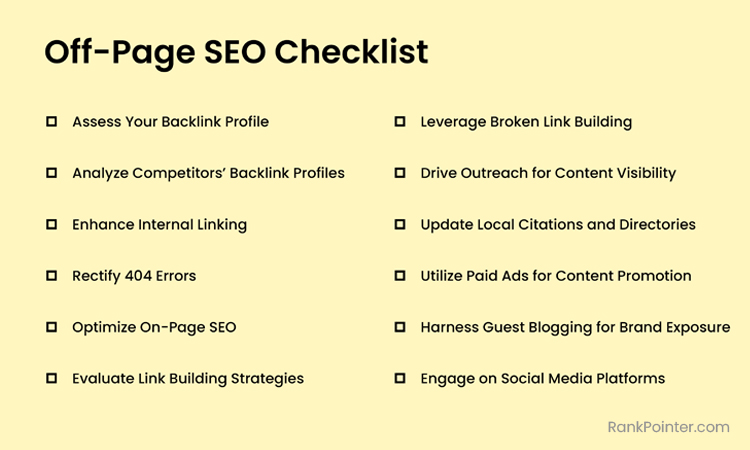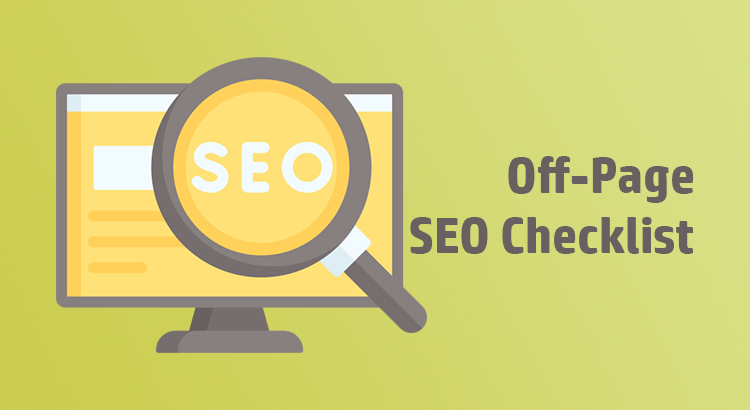Off-page SEO presents significant challenges alongside fewer readily available solutions. Securing a top position in search results, accompanied by increased traffic, leads, and revenue, hinges on effectively optimizing your off-page SEO presence. This article provides a comprehensive 12-step off-page SEO checklist.
12-Step Off-Page SEO Checklist
1. Assess Your Backlink Profile
Utilize tools such as Google Search Console, Ahrefs, or Moz to scrutinize your backlink profile. Evaluate the domains and pages linking to your site, and consider metrics like domain authority (DA) or domain rating (DR) for an overall profile score.
2. Analyze Competitors’ Backlink Profiles
Gain insights into the strength of your backlink profile by examining those of your competitors. Tools like Ahrefs, Moz, or SEMrush can aid in this process, allowing you to export and analyze data for informed decision-making.
3. Enhance Internal Linking
Boost your off-page SEO strategy by optimizing internal linking. Ensure each page receives at least three links from existing pages with optimized anchor text. Tools like Screaming Frog can identify pages lacking links, facilitating necessary adjustments.
4. Rectify 404 Errors
Address broken links promptly to uphold user experience and off-page SEO integrity. Employ tools like Screaming Frog to identify and rectify 404 errors, ensuring seamless browsing for both users and search engine crawlers.
5. Optimize On-Page SEO
Coordinate off-page efforts with on-page optimizations to maximize SEO ROI. Adhering to SEO best practices is crucial for enhancing search engine rankings and overall visibility.
6. Evaluate Link Building Strategies
Assess available link building strategies based on their value and feasibility. Prioritize approaches aligned with your resources, expertise, and objectives, such as guest blogging, broken link reclamation, or paid advertising.
Related Article: How to Get Backlinks for Your Website: Strategic Steps
7. Leverage Broken Link Building
Capitalize on broken link building by identifying broken external links on target sites and offering relevant content as replacements. Initiate outreach to relevant websites, presenting your content as a viable solution.
8. Drive Outreach for Content Visibility
Utilize tools like BuzzSumo and Inkybee to maximize the impact of outreach efforts. Craft pitches centered around the problem-solving aspect of your content, targeting bloggers, editors, and webmasters for link acquisition.
9. Update Local Citations and Directories
Enhance off-page SEO by maintaining accurate information across trusted local citation sites and directories, such as Google Business Profile. Avoid spammy directories and utilize citation management tools for streamlined management.
10. Utilize Paid Ads for Content Promotion
Leverage platforms like Google Ads and Facebook to promote high-value content and drive traffic to your site. Regular monitoring and optimization are essential for maximizing the effectiveness of ad campaigns.
11. Harness Guest Blogging for Brand Exposure
Expand brand awareness and acquire valuable backlinks through strategic guest blogging. Identify relevant blogs in your industry, pitch compelling topics, and contribute guest posts to broaden your reach.
12. Engage on Social Media Platforms
Leverage social media platforms like Facebook, LinkedIn, and Instagram to amplify your content’s reach. Share informative and engaging content to foster discussion, shares, and inbound links to your website.

Conclusion of Off-Page SEO Checklist
Implementing an effective off-page SEO strategy is paramount for achieving higher search engine rankings and driving organic traffic to your website. By meticulously following this 12-step off-page SEO checklist, businesses can enhance their online visibility, attract quality backlinks, and solidify their position in the SERPs.


